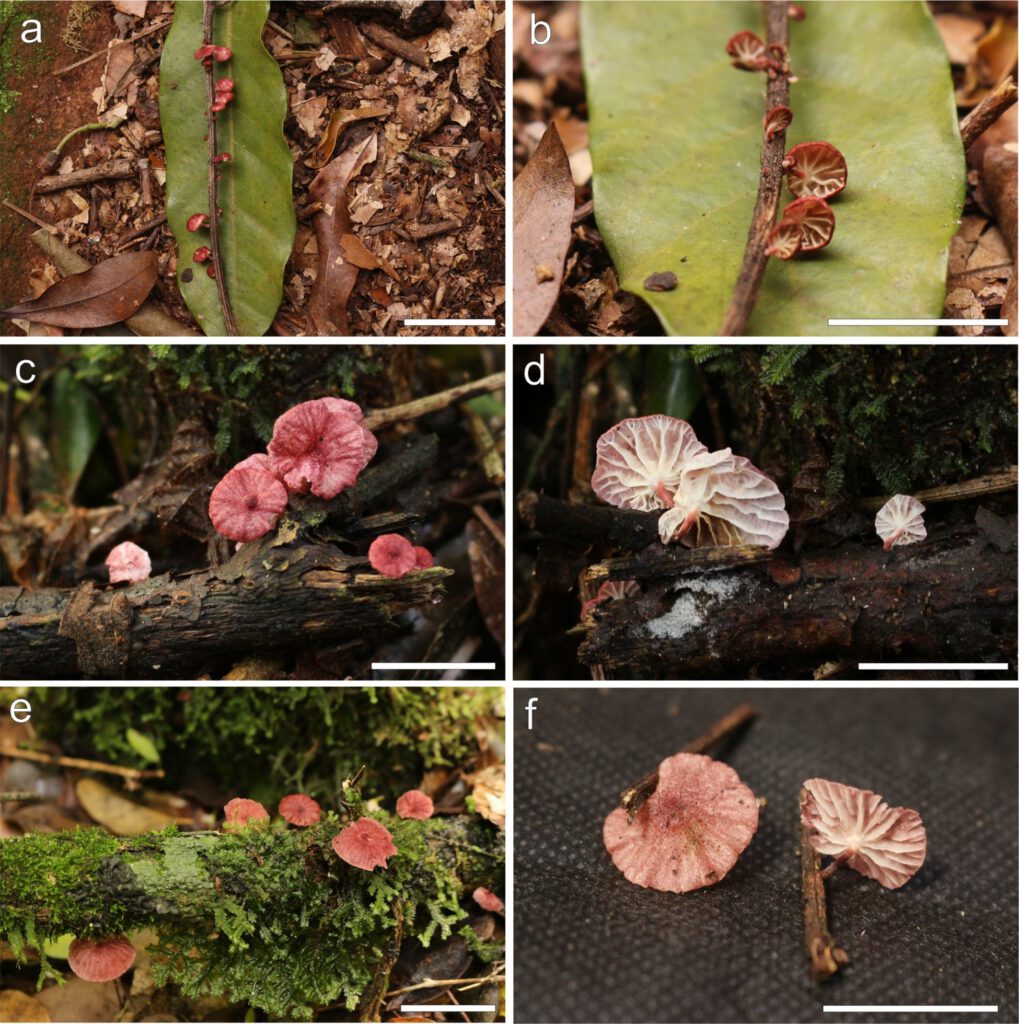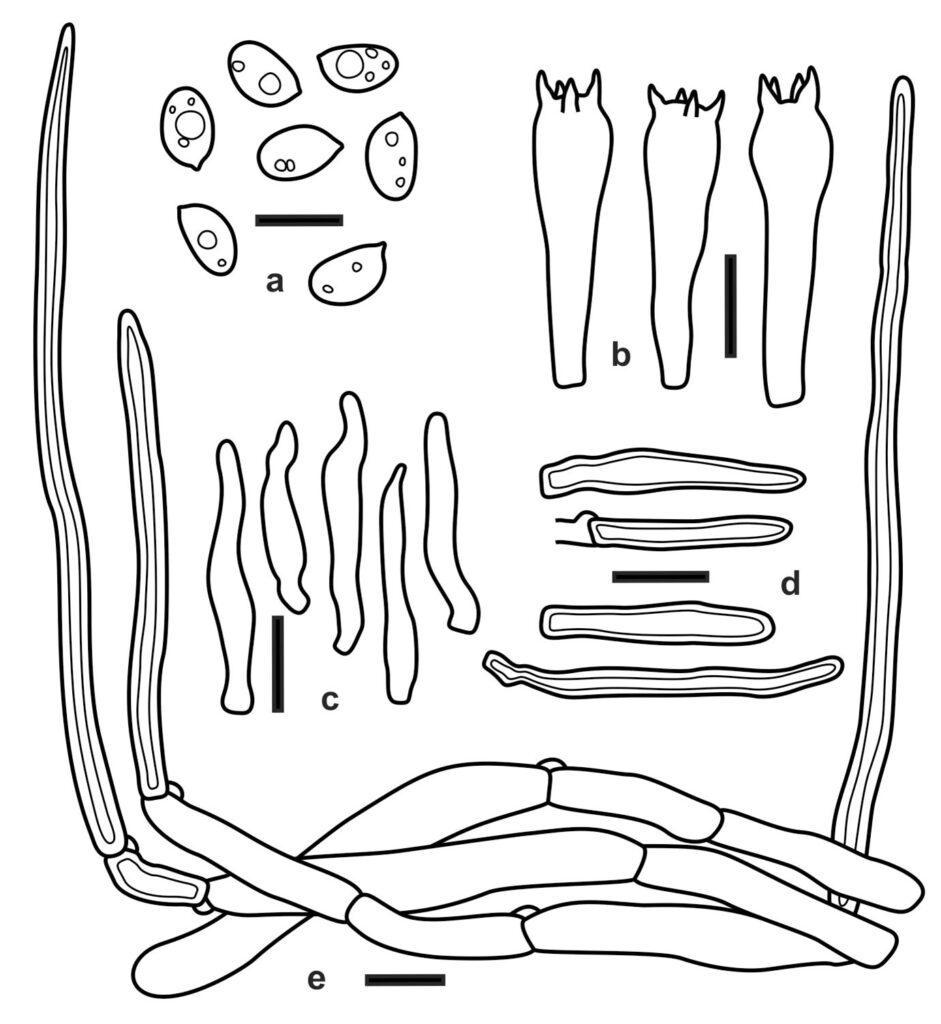Moniliophthora atlantica N.A. Ramirez & Niveiro.
MycoBank number: MB 555944; Index Fungorum number: IF 555944; Facesoffungi number: FoF 10838;
Description
Pileus 3–20 mm diam., circular, convex to broadly convex when mature, some subumbonated, slightly depressed at center, surface pale red (7A3-8A3), pastel red (7A4-8A4), dull red (8B4-8C4) to greyish red (8B5-8C5), usually darker near the center, reddish brown (8D7-8E6-7); surface fibrillose to pubescent, dry, opaque, not hygrophanous, sulcate-striate; margin incurved to plane. Context thin (< 1 mm), membranaceous, yellowish white (1A2), odor and taste not tested. Lamellae free to slightly adnexed, subdistant, regular, sometimes furcate towards the margin and with intervenose, lamellulae I 2-3 series, yellowish white (1A2) to pale yellow (1A3), smooth margin, concolorous with sides. Stipe 2–12 × 0.8–2 mm, central, sometimes slightly lateral, cylindrical, equal or slightly thinner towards the middle, hollow, insititious, apex concolorous with lamellae, yellowish white (4A2), turning pale orange (6A4-6B4) towards the middle of the stipe, darkening towards the base, reddish brown (9E6-7) to dark brown (9F6-8), surface fibrillose, pubescent under lens, more distinctive toward the base. Spore-print not observed, presumably yellowish white (1A2). KOH and NaOH reactions on pileus surface negative. Basidiospores (7–)8.2–11.1 × 4.5–6.2(–7.2) µm, x = 9.4 ± 0.77 × 5.6 ± 0.45 µm, Q= 1.4–2.1, Qx= 1.7 ± 0.12, n= 25, N=2, ellipsoidal to oblong, amygdaliform in lateral view, with a slight suprahilar depression, thin-walled, smooth, hyaline, inamyloid, without germ-pore. Basidia 34.7–50 × 7.5–9 μm, clavate to narrowly clavate, 4-spored, thin-walled. Basidioles 22.2–34 × 4–7.7 μm, clavate, thin-walled, abundant. Pleurocystidia absent. Cheilocystidia 18–33.2 × 2.5–6.4 μm, subcylindrical to narrowly clavate, sometimes with a finger-like apical protuberance, rounded apex, thin-walled, hyaline. Trama hymenophoral subregular, composed of cylindrical interwoven hyphae, up to 7 μm diam., thin-walled, hyaline. Pileipellis a cutis of repent, more or less interwoven cylindrical hyphae, up to 8 μm broad, thin-walled, smooth, hyaline, inamyloid, covered by clusters of dextrinoid hairs. Hairs of the pileus surface 50–315 × 4–8.5 μm, setiform, acicular, thick-walled, up to 3 μm broad, dextrinoid, sometimes with secondary septa, rounded apex, KOH- (do not turn olive green). Stipitipellis a cutis of repent hyphae, up to 8 µm diam., parallel, elongated, dextrinoid. Hairs of the stipe surface 20.1–44.1 × 4.4–8.3 μm, setiform, similar to hairs of the pileus surface, thick-walled, up to 2 μm broad, dextrinoid, more abundant in young specimens. Clamp connections presents. Habit and habitat: marasmioid, growing on small freshly fallen branches of unidentified dicots and stems of living lianas. Asexual state: not observed.
Material examined: ARGENTINA, Misiones, San Ignacio, Osununú Private Reserve, 27°17’09.3″ S, 055°34’03.6″ O, 206 m asl, on recently fallen branches, 30/IX/2018, leg. Ramirez N. et al., OS17-2-7 (CTES 0568284, holotype). Ib., Osununú Private Reserve, 27°17’09.3″ S, 055°34’03.6″ O, 206 m asl, on recently fallen branches, 30/IX/2018, on recently fallen branches leg. Ramirez N. et al., OS18-2-5 (CTES). Ibid. Teyú Cuaré Provincial Park, 27°17’05.5″ S, 055°35’21.1″ O, 177 m asl, on living liana, 01/X/2018, leg. Ramirez N. et al., TC19-2-1 (CTES); Iguazú, Iguazú National Park, 25°43’29.2″ S, 054°28’08.6″ O, 239 m asl, 02/X/2018, leg. Ramirez N. et al., IG16-3-11 (CTES 0568285). Ibid. Palmital, 25°41’19.7″ S, 054°28’26.3″ O, 186 m asl, 13/X/2017, leg. Ramirez N. et al., IG10-1-1 (CTES).
Distribution: Misiones province, Argentina.
Sequence data: ITS (ITS1F/ITS4B): ON180675 (CTES 0568284), ON180677 (CTES 0568285)
Notes: The most related species, Moniliophthora perniciosa, is a widely studied species since it is the cause of the main disease of cocoa (Theobroma cacao L.) called “witches´ broom”, and has been reported in numerous hosts of different families, such as Malvaceae, Malpighiaceae, Solanaceae, Bixaceae, Sapindaceae, Asteraceae, and lianas, possibly belonging to the Bignoniaceae (Lisboa et al. 2020). These authors observed in the hosts the presence of symptoms caused by the fungus, concluding that there are non-pathogenic life forms [on lianas and Allophylus edulis (A. St.-Hil., A. Juss. & Cambess.) Hieron. ex Niederl.] and pathogenic forms (in the other hosts studied). Considering the absence of symptoms or visible anomalies in the hosts of M. atlantica at the time of collection, this species can be classified as non-pathogenic. However, it should be highlighted that a more extensive sampling, with a more detailed study of its hosts and studies including other regions of the genome is considered necessary to define this issue.

Fig. 1: Moniliophthora atlantica, general aspect, lamellae and stipe: a-b TC17-2-7 (holotype) c-d OS18-2-5 e TC19-2-1 f IG16-3-11. Scale bars = 20 mm.

Fig. 2: Moniliophthora atlantica microscopic characters. a Basidiospores. b Basidia. c Cheilocystidia. d Caulocystidia. e Pileipellis elements. Scale bars = 10 μm.
